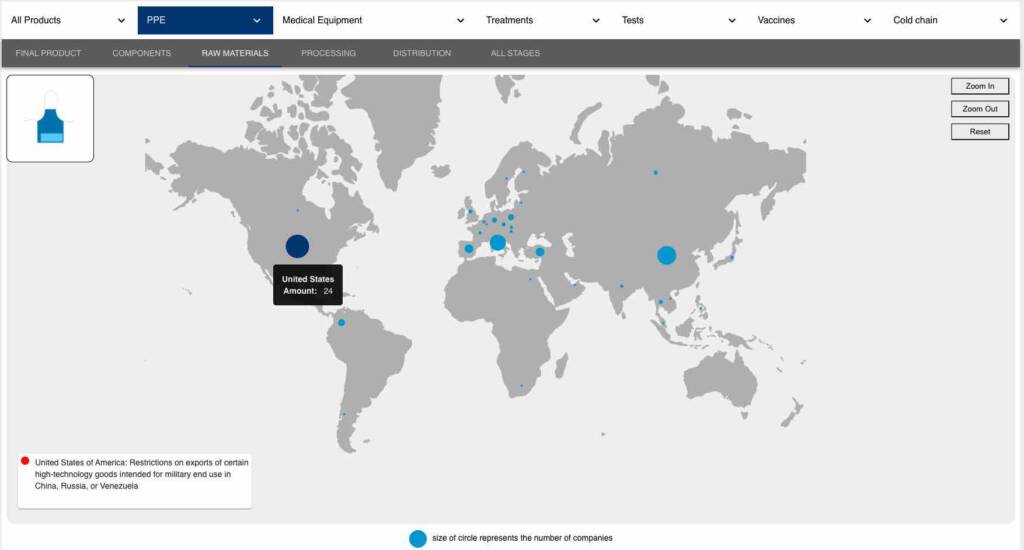Additional material by Can Sutken and Ankita Pandey
Staff at the Asian Development Bank’s (ADB) Trade and Supply Chain Finance Program came across a serious knowledge gap in the early days of the COVID-19 pandemic, when supply chain problems were hindering global procurement of key medical products needed in the fight.
When we heard about the issues with the supply chains, we started asking our bank partners which companies in their portfolios were involved in the supply chains for these products. The idea was that we could help shine a spotlight and get help to where it was needed.
But as it turned out, that information was not available. Even the banks did not have a clear picture of whether the companies they worked with were involved in the supply lines.
That kind of information was not available in a way that would make it easy for someone to address problems that might arise. We decided to see if that was something we could do.
The solution was the creation of an interactive mapping tool for the supply chains of products vital to those on the frontlines of the battle. These would allow governments, banks, investors, healthcare professionals, and companies to trace the firms that make every component in products such as masks or portable ventilators, down to the metal and rubber that goes into each part.

The information on who makes which part and for which product was available in piecemeal fashion before the ADB effort. But it was information that had never been brought together into one database that would allow for such a quick search.
The TSCFP was in a prime position, firstly to understand the problem, and then to act on it.
ADB and the Trade and Supply Chain Finance Program were already heavily involved in efforts to fight the pandemic. In April 2020, ADB approved a $20 billion package to support its developing members in addressing the impacts of the pandemic and streamlined some procedures to deliver quicker and more flexible assistance.

Part of those efforts included more flexibility and targeted support for trade and supply chains. Since April, the Trade and Supply Chain Finance Program has supported about 7,000 transactions worth around $5 billion, including about $240 million in medical and pharmaceutical goods.
By the end of May, the mapping tool was up and running for anyone to use free of charge on the ADB website, where it has been used 13,000 times. There, anyone can search a database of around 20,000 companies involved in supply chains around the world.
Big international banks found they could use the ADB tool to help their clients cut through the noise surrounding efforts to increase production or shipments of pandemic-related products. Companies, academics, and other international organisations also began using the tool.
As the number of those using the tool has expanded, so has the mapping tool. From the initial seven products mapped, the tool now maps about 33, including the supply chains of vaccines and related goods such as the equipment that keeps vaccines cold en route to where they are needed.
But the uses for the mapping tool don’t stop there. It also incorporates a visual representation of the data in the form of a heat map. A quick glance will illustrate the number of companies involved in the supply chain flows in the market by value, and risks to those flows via factors like trade restrictions or blockages. The distribution flow of the vaccine and cold chain storage will also be represented visually.
The tool may be useful beyond the pandemic, tracking other supply chains vital to development, such as food and agricultural supplies.
ADB’s efforts to offset the effects of the pandemic have also continued to ramp up. In December 2020, it announced a $9 billion vaccine initiative, the Asia Pacific Vaccine Access Facility, to provide funding for vaccine procurement and logistics costs, as well as for successful distribution, delivery, and administration of vaccines. It will also support important investments to build capacity in vaccine delivery, community outreach, and surveillance.
Included in that effort is a $500-million Vaccine Import Facility from the Trade and Supply Chain Finance Program to support its developing members in securing safe and effective vaccines, as well as the goods that support distribution and inoculation. AAA-guarantees available through the programme’s vaccine import facility will mitigate payment risks and facilitate import of these goods.

































